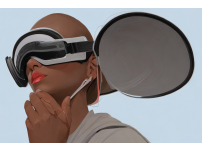요리산업에서의 가상현실(VR) 활용 : 요리 및 제빵교육 강화(The Use of Virtual Reality in the C…
본문
가상 현실(VR)은 우리가 살고, 일하고, 노는 방식에 혁명을 일으킬 수 있는 잠재력을 가진 새로운 기술입니다. 최근 몇 년 동안, VR은 요리 산업을 포함한 다양한 산업으로 진출했습니다. 이 기술은 요리사와 요리 학생들이 배우고, 실험하고, 그들의 요리와 제빵 기술을 향상시킬 수 있는 독특한 플랫폼을 제공했습니다.
요리 산업에서 VR은 전통적인 요리책이나 비디오 튜토리얼보다 더 인터랙티브하고 몰입감 있는 학습 경험을 제공합니다. VR로, 학생들과 요리사들은 세계의 다른 주방, 요리 학교, 그리고 제빵 가게를 가상으로 방문할 수 있고, 그곳에서 그들은 최고의 요리사들로부터 배우고 다양한 재료와 도구들과 상호 작용할 수 있습니다. VR 환경은 학생들이 안전하고 통제된 환경에서 요리와 베이킹 기술을 연습할 수 있게 해주어 사고의 위험을 줄이고 낭비를 줄일 수 있습니다.
요리 산업에서 VR을 사용하는 한 가지 예는 한국 회사인 "음식 이론"입니다 푸드 이론은 가상 요리를 준비하고 요리 기술을 연습할 수 있는 VR 요리 시뮬레이션 플랫폼을 개발했습니다. 플랫폼에는 다양한 조리법과 재료가 포함되어 있으며, 사용자는 다양한 조리 방법과 맛 조합을 실험할 수 있습니다. 게다가, Food Theory는 학생들에게 VR 플랫폼에 대한 접근을 제공하고 그들이 가상 부엌 환경에서 직접 경험을 얻을 수 있도록 하면서 요리 학교 및 요리 학원과 파트너 관계를 맺었습니다.
또 다른 예는 한국 요리 학교인 "쿡스페이스"가 제공하는 VR 요리 수업입니다 쿡스페이스는 VR 기술을 요리 수업에 도입하여 학생들이 더 상호작용적이고 매력적인 방식으로 요리와 제빵에 대해 배울 수 있도록 했습니다. 쿡스페이스의 VR 플랫폼은 학생들에게 가상의 요리를 준비하고, 재료로 실험하고, 최고의 요리사로부터 요리 기술을 배울 수 있는 가상의 부엌 환경을 제공합니다.
결론적으로, 요리 산업에서 VR의 사용은 요리사와 요리 학생들에게 많은 이점을 제공합니다. 이 기술은 보다 몰입적이고 상호작용적인 학습 경험을 가능하게 하여 사고의 위험을 줄이고 다양한 재료와 조리 방법으로 실험할 수 있는 플랫폼을 제공합니다. 점점 더 많은 요리사와 요리 학교가 이 기술과 이점을 수용함에 따라 요리 산업에서 VR의 채택은 앞으로 몇 년 동안 증가할 것입니다. VR과 함께 요리 산업은 더 밝고 혁신적인 미래를 위한 준비가 되어 있습니다.
가상 현실 기술은 요리 산업을 포함한 다양한 산업으로 진출해 왔습니다. 요리 산업에서, 가상 현실은 전문 요리사와 가정 요리사 모두를 위한 요리와 제빵 교육을 강화하는 데 사용될 수 있습니다. 가상 현실을 통합함으로써, 요리사와 제빵사들은 가상 부엌에서 직접 경험을 할 수 있는데, 이것은 처음 시작하는 사람들이나 새로운 기술을 배우려는 사람들에게 특히 도움이 될 수 있습니다.
요리 산업에서 가상 현실의 주요 장점 중 하나는 실제 부엌에서는 불가능한 수준의 실험과 창의성을 허용한다는 것입니다. 예를 들어, 가상 현실은 실제 주방에서 만들기에 너무 어렵고 시간이 많이 걸리거나 비용이 많이 드는 맞춤형 재료와 요리를 만드는 데 사용될 수 있습니다. 가상 현실은 또한 요리사와 제빵사들이 실제 음식이나 재료의 필요 없이 굽기, 굽기, 베이킹과 같은 다른 요리 기술을 연습할 수 있게 해줍니다.
게다가, 가상 현실은 가상 요리 수업이나 가상 음식 축제와 같은 상호 작용적인 요리 경험을 만드는 데 사용될 수 있습니다. 이러한 가상의 경험은 요리사와 제빵사들이 고객들과 연결되고 그들의 브랜드를 구축할 수 있는 좋은 방법일 뿐만 아니라 미식가들이 전 세계의 다양한 요리와 요리를 경험할 수 있는 좋은 방법이 될 수 있습니다.
요리 산업에서 가상 현실의 사용을 보여주는 한국과 관련된 사례는 한국계 미국인 슈퍼마켓 체인인 H 마트가 제공하는 가상 요리 강좌입니다. H 마트의 가상 요리 교실은 가상 현실을 사용하여 실제 주방을 시뮬레이션하여 고객들이 직접 체험하고 상호 작용하는 방식으로 한국 요리를 만드는 방법을 배울 수 있도록 합니다. 이러한 가상 수업들은 큰 성공을 거두었고 H 마트가 한국 요리에 대해 배우는 것에 관심이 있는 새로운 세대의 고객들을 끌어들이는 데 도움이 되었습니다.
결론적으로, 요리 산업에서의 가상 현실의 활용은 아직 초기 단계이지만, 이미 요리와 제빵 교육을 향상시킬 수 있는 큰 잠재력을 보여주었습니다. 가상 현실은 요리사와 제빵사가 새로운 재료와 요리를 실험할 수 있는 독특하고 상호작용적인 방법을 제공할 뿐만 아니라 고객이 다양한 요리와 요리 기술을 경험할 수 있도록 합니다. 가상 현실 기술의 지속적인 성장과 발전으로, 우리는 미래에 요리 산업에서 훨씬 더 흥미롭고 혁신적인 가상 현실의 사용을 보게 될 것입니다.
Virtual Reality (VR) is an emerging technology that has the potential to revolutionize the way we live, work, and play. In recent years, VR has made its way into various industries, including the culinary industry. This technology has provided a unique platform for chefs and culinary students to learn, experiment, and improve their cooking and baking skills.
In the culinary industry, VR offers a more interactive and immersive learning experience than traditional cookbooks or video tutorials. With VR, students and chefs can virtually visit different kitchens, cooking schools, and baking shops around the world, where they can learn from top chefs and interact with various ingredients and tools. The VR environment allows students to practice their cooking and baking techniques in a safe and controlled environment, reducing the risk of accidents and reducing waste.
One example of the use of VR in the culinary industry is the Korean company “Food Theory.” Food Theory has developed a VR cooking simulation platform that allows users to prepare virtual dishes and practice cooking techniques. The platform includes a variety of recipes and ingredients, and allows users to experiment with different cooking methods and flavor combinations. In addition, Food Theory has partnered with cooking schools and culinary academies, providing students with access to the VR platform and allowing them to gain hands-on experience in a virtual kitchen environment.
Another example is the VR cooking classes offered by a Korean cooking school, “Cookspace.” Cookspace has implemented VR technology into its cooking classes, allowing students to learn about cooking and baking in a more interactive and engaging manner. Cookspace’s VR platform provides students with a virtual kitchen environment, where they can prepare virtual dishes, experiment with ingredients, and learn cooking techniques from top chefs.
In conclusion, the use of VR in the culinary industry offers many benefits for chefs and culinary students. This technology allows for more immersive and interactive learning experiences, reducing the risk of accidents, and providing a platform for experimenting with different ingredients and cooking methods. The adoption of VR in the culinary industry is likely to increase in the coming years, as more and more chefs and culinary schools embrace this technology and its benefits. With VR, the culinary industry is poised for a brighter and more innovative future.
Virtual reality technology has been making its way into various industries, including the culinary industry. In the culinary industry, virtual reality can be used to enhance cooking and baking education for both professional chefs and home cooks. By incorporating virtual reality, chefs and bakers can get hands-on experience in a virtual kitchen, which can be especially beneficial for those who are just starting out or for those who are looking to learn new skills.
One of the key advantages of virtual reality in the culinary industry is that it allows for a level of experimentation and creativity that is not possible in a real kitchen. For example, virtual reality can be used to create custom ingredients and dishes that would otherwise be too difficult, time-consuming, or expensive to create in a real kitchen. Virtual reality also allows chefs and bakers to practice different cooking techniques, such as grilling, roasting, and baking, without the need for any actual food or ingredients.
In addition, virtual reality can be used to create interactive culinary experiences, such as virtual cooking classes or virtual food festivals. These virtual experiences can be a great way for chefs and bakers to connect with their customers and build their brand, as well as for foodies to experience different cuisines and dishes from around the world.
A case related to Korea that showcases the use of virtual reality in the culinary industry is the virtual cooking classes offered by H Mart, a Korean-American supermarket chain. H Mart's virtual cooking classes use virtual reality to simulate a real kitchen, allowing customers to learn how to cook Korean dishes in a hands-on and interactive manner. These virtual classes have been a huge success and have helped H Mart to attract a new generation of customers who are interested in learning about Korean cuisine.
In conclusion, the use of virtual reality in the culinary industry is still in its early stages, but it has already shown great potential for enhancing cooking and baking education. Virtual reality provides a unique and interactive way for chefs and bakers to experiment with new ingredients and dishes, as well as for customers to experience different cuisines and cooking techniques. With the continued growth and development of virtual reality technology, it is likely that we will see even more exciting and innovative uses of virtual reality in the culinary industry in the future.














댓글목록 0